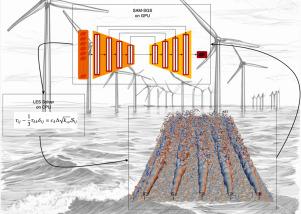Towards a machine-learning-based large eddy simulation of offshore wind farms
IF 3
3区 工程技术
Q3 COMPUTER SCIENCE, INTERDISCIPLINARY APPLICATIONS
引用次数: 0
Abstract
This study introduces a Scale-Adaptive Machine-Learning Subgrid-Scale model developed to predict subgrid-scale turbulence within the framework of large eddy simulations for offshore wind farms. Unlike traditional subgrid-scale models that rely on blending of isotropy and scale similarity, the proposed approach leverages a supervised learning framework based on physically informed flow observables derived from mixed modelling theory and Leonard decomposition. The model employs a novel encoder–decoder neural network architecture designed to capture coherent enstrophy dynamics and multi-scale turbulence interactions. Skip connections and latent representations serve as implicit filters, enabling the model to represent both structural and functional aspects of turbulence. Trained using data from a scale-adaptive LES method, outcome of the presented model has been validated for its ability to learn and reproduce key turbulence characteristics, such as intermittency and energy transfer, across resolutions and flow scenarios. A-priori tests confirm its capacity to capture statistical turbulence features, while a-posteriori tests demonstrate that the model dynamically predicts eddy viscosity and produces flow fields comparable to high-resolution LES with traditional SGS models. When applied on coarser meshes, the model maintains accuracy, as evidenced by agreement in the ratio of subgrid to total kinetic energy. These findings support the potential of this machine-learning-based model as a physics-aware, scalable modelling approach for complex turbulent flows.

基于机器学习的海上风电场大涡模拟
本研究介绍了一种尺度自适应机器学习亚网格尺度模型,该模型用于预测海上风电场大涡模拟框架内的亚网格尺度湍流。与传统的依赖于各向同性和尺度相似性混合的子网格尺度模型不同,该方法利用了一个基于混合建模理论和伦纳德分解衍生的物理信息流观察值的监督学习框架。该模型采用一种新颖的编码器-解码器神经网络架构,旨在捕捉相干熵动力学和多尺度湍流相互作用。跳过连接和潜在表示充当隐式过滤器,使模型能够同时表示湍流的结构和功能方面。使用尺度自适应LES方法的数据进行训练,所提出的模型的结果已被验证,因为它能够学习和重现关键的湍流特征,如间歇性和能量转移,跨越分辨率和流动场景。先验测试证实了其捕获统计湍流特征的能力,而后验测试表明,该模型可以动态预测涡流粘度,并产生与传统SGS模型的高分辨率LES相媲美的流场。当应用于较粗的网格时,该模型保持了精度,从子网格占总动能的比例上可以看出一致性。这些发现支持了这种基于机器学习的模型作为一种物理感知的、可扩展的复杂湍流建模方法的潜力。
本文章由计算机程序翻译,如有差异,请以英文原文为准。
求助全文
约1分钟内获得全文
求助全文
来源期刊

Computers & Fluids
物理-计算机:跨学科应用
CiteScore
5.30
自引率
7.10%
发文量
242
审稿时长
10.8 months
期刊介绍:
Computers & Fluids is multidisciplinary. The term ''fluid'' is interpreted in the broadest sense. Hydro- and aerodynamics, high-speed and physical gas dynamics, turbulence and flow stability, multiphase flow, rheology, tribology and fluid-structure interaction are all of interest, provided that computer technique plays a significant role in the associated studies or design methodology.
 求助内容:
求助内容: 应助结果提醒方式:
应助结果提醒方式:


